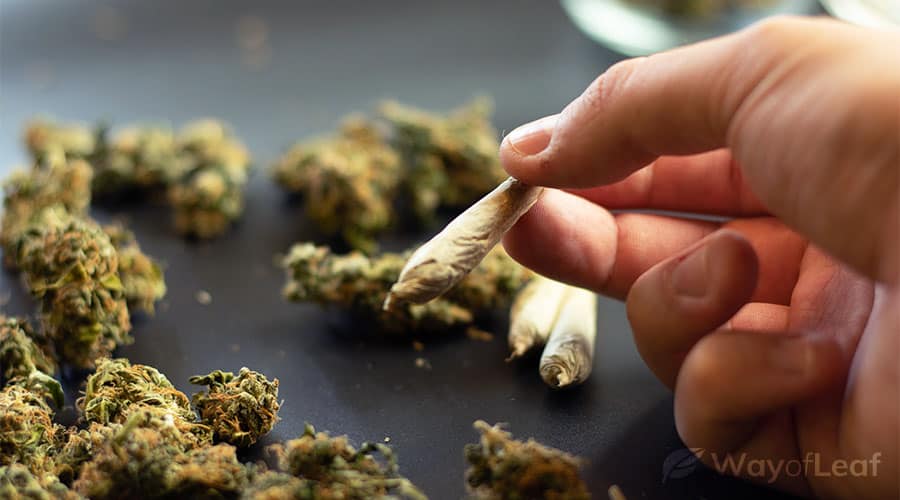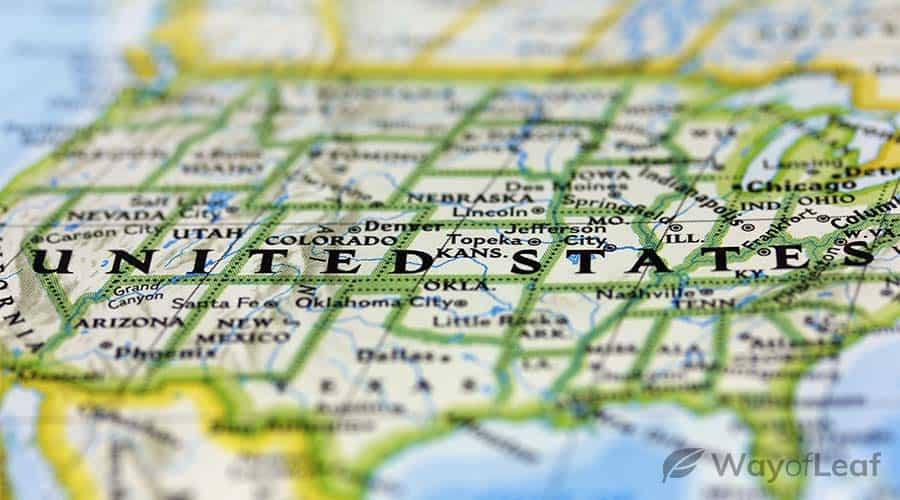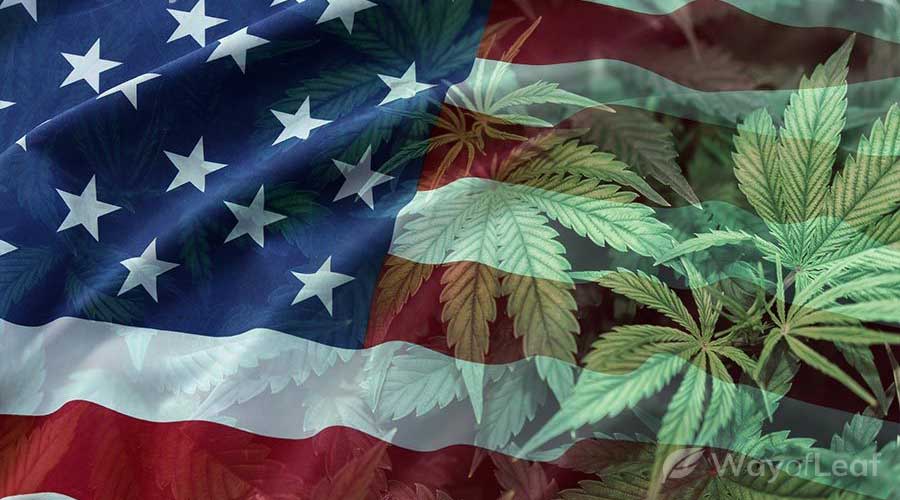A significant majority of American states have legalized medicinal marijuana. Meanwhile, the number of states that permit recreational cannabis grows annually. The nation’s northern neighbor, Canada, fully legalized weed in October 2018, and it is likely that Mexico, to the south, will also allow fully legal marijuana sooner rather than later.
The pressure is mounting on the American government to end almost 90 years of prohibition, but successive administrations have resisted calls to make the change. However, if you live in or visit a state where marijuana is recreationally legal, you can enjoy the substance hassle-free. That is if you’re aged 21+ and ensure you remain within the state’s possession and purchasing laws.
This article looks at every state (plus the District of Columbia) that has legalized recreational marijuana.
Alaska
Marijuana was decriminalized in Alaska in 1975 but re-criminalized in 1990. The state veered between criminalization and decriminalization in the early 2000s. However, Measure 2, a ballot initiative to make marijuana legal for recreational use, was successful in 2014. It came into effect on February 24, 2015.
It was the third state to allow recreational cannabis, and adults aged 21 and older can possess up to one ounce. Alaskans are also permitted to grow six marijuana plants, but only three can be mature and flowering at one time. Possession of marijuana accessories is also legal.
Arizona
Arizonans have fought hard to bring cannabis to their state. They were rewarded when 50.1% of voters said ‘yes’ to Proposition 203 in 2010. It legalized the use of MMJ, and patients could possess up to 2.5 ounces. The state threatened to go further, but Proposition 205, designed to legalize recreational weed, narrowly failed in 2016.
The Smart and Safe Act allows adults to use up to one ounce of marijuana.
However, there was no stopping Proposition 207 in 2020. The Smart and Safe Act allows adults to buy and possess up to one ounce of marijuana. Furthermore, every adult in Arizona is allowed to grow up to six plants at home.
The Arizona Department of Health Services (ADHS) began issuing licenses in early 2021. Retail sales started in February 2021.
California
In 1975, possession of an ounce or less was downgraded to a misdemeanor. The Golden State had the country’s first ballot initiative to legalize pot through Proposition 19 in 1972. Although it was unsuccessful, it paved the way for California to become the first state to legalize medical marijuana in 1996 via Proposition 215.
It took a surprisingly long time for California to legalize recreational weed. It finally did so through Proposition 64 in November 2016. However, recreational sales didn’t begin until January 2018.
Today, adults aged 21+ can purchase, consume, and possess up to an ounce of weed. You can do this either at home or in a specific establishment licensed for weed consumption. You are also allowed to possess up to eight grams of concentrate and cultivate a maximum of six mature and 12 immature plants in your home.
Colorado
Medical marijuana became legal thanks to Amendment 20 in 2000. However, residents of Colorado had to wait until the enactment of Amendment 64 in November 2012 before the herb became legal recreationally.
You are only allowed to purchase a maximum of one ounce per transaction and possess a maximum of two ounces. Most stores play it safe and won’t sell to you again that day, even if you come back later. Recreational marijuana laws changed in October 2016. You could possess a maximum of eight grams of concentrate or 800 mg of edibles from then on. Finally, you can grow up to six marijuana plants indoors, but only three can be mature.
Connecticut
The Constitution State had an MMJ program for almost a decade before permitting adult-use marijuana. In June 2011, Governor Malloy signed legislation decriminalizing the possession of small amounts of weed. In June 2012, he signed a medical marijuana law in Connecticut.
An attempt to push through recreational marijuana in April 2018 stalled. However, this effort was renewed three years later, with Governor Ned Lamont vowing that the state would have recreational sales by 2022. In June 2021, he signed Senate Bill 1201, legalizing adult-use marijuana in Connecticut.
Adults in the state can buy up to an ounce of marijuana. They can also have a maximum of 1.5 ounces on their person and no more than 5 ounces stored in their homes or locked in glove boxes or car trunks. In addition, it’s now possible to grow a maximum of six marijuana plants indoors, three of which can be mature. The limit increases to 12 plants in a household with two or more adults.
Delaware
In April 2023, Governor John Carney permitted HB1 and HB2 to become law without his signature. This came more than a decade after MMJ became legal within the state and eight years after the decriminalization of the possession of up to an ounce of the substance.
Legal recreational sales are likely to begin in late 2024 or early 2025. At that point, adults aged 21 and older will be allowed to buy and possess up to an ounce of marijuana. However, it remains illegal to cultivate marijuana in Delaware, even with an MMJ card.
Illinois
The state of Illinois permitted an MMJ program in 2013. The number of qualifying conditions grew, and there are currently more than 30.
Recreational cannabis officially became legal in the state at the beginning of 2020. Now, adults aged 21 and older can buy up to 30 grams of flower, 500mg of THC, or 5 grams of cannabis concentrate. It’s also legal to grow a maximum of five plants in a private residence.
Maine
Weed was decriminalized in 1976 and became legal for medicinal use in 1999. In 2016, Maine voted ‘Yes’ to Question 1, which resulted in the statewide legalization of recreational marijuana. It was a close-run thing, as the measure passed by less than one percentage point!

Residents of Maine had to wait to celebrate, however. The state’s governor vetoed a bill to tax and regulate recreational marijuana sales in November 2017. His veto was finally overturned in May 2018, and the bill became law.
The new law allows Maine residents aged 21 and older to possess 2.5 ounces of marijuana and grow up to six flowering plants and 12 immature plants. They can also possess an unlimited number of seedlings. Furthermore, Maine employers are no longer permitted to test job applicants for cannabis.
Massachusetts
After marijuana was decriminalized in 2008, the state of Massachusetts swiftly moved to have medical cannabis made available. This was made possible in 2012 when Question 3 passed with 60% of the vote.
Fast forward to 2016, and the state legalized recreational weed after Question 4 passed with 54% of the vote.
The state made provisions for home cultivation in December 2016. Massachusetts adult residents are now allowed to possess one ounce and grow up to six plants.
If the residence has more than one adult, it is possible to grow 12 plants as long as they remain obscured from public view. The sale of recreational weed began in July 2018.
Michigan
Medical marijuana was legalized in 2008 after 63% of voters said ‘Yes’ to Prop 1. Recreational use was not decriminalized until 2018. This fact made it mildly surprising that in November 2018, almost 56% of voters voted to legalize weed for recreational use via Proposal 1.
Michigan became the tenth state to allow recreational cannabis and the first in the Midwest. According to the law, adult residents can grow a maximum of six plants, or 12 in a household with two or more adults. They can possess up to 2.5 ounces in public and 10 ounces at home.
Minnesota
Minnesota is among the states that have recently legalized recreational marijuana. It did so in May 2023, when Governor Tim Walz signed House File 100 into law. In August 2023, it became legal to possess marijuana in public. Minnesota allowed the distribution of MMJ in 2015, so full legalization has been a long time coming.
However, legal sales of recreational marijuana in the state probably won’t begin until 2025. At that point, it will become possible to purchase and possess up to two ounces of dried flower or 8 grams of cannabis concentrate in person. It also became legal to cultivate up to eight plants at home in August 2023.
Missouri
In November 2022, a ballot initiative to legalize recreational use passed by a narrow margin. It has seemed inevitable that this would happen ever since Missouri legalized MMJ in 2018.
Now, adults aged 21 and older can legally purchase marijuana and possess up to three ounces. Furthermore, they’re free to cultivate up to six flowering plants, six immature plants, and six plants under 14 inches tall in a private residence.
Montana
Montana has one of the longest-running MMJ programs in the United States. Over 60% of voters approved Measure I-148 in 2004. Therefore, it was a surprise that it took so long for Montana to take the next step. That said, the state legislature introduced several restrictions on the MMJ program in 2011.
The state has moved towards a more cannabis-friendly attitude in recent years. The change in stance culminated in the legalization of adult-use cannabis via I-90 and CI-118 in November 2020. The law permits adults aged 21 and older to possess up to an ounce of weed without an MMJ card.
Also, Montana residents can grow up to eight plants, four of which can be mature, in a private residence. The law came into effect at the beginning of 2021, and recreational sales started in January 2022.
Nevada
Nevada was one of the first states to legalize medical marijuana in 2000. It was no surprise when Question 2, an initiative to legalize recreational cannabis, passed with 54% of the vote in November 2016. The initiative became law in January 2017.
Residents and tourists can possess up to 2.5 ounces of weed as long as they are 21 or older. You can also possess up to seven grams of cannabis concentrate.
You can grow up to six plants per household or 12 plants if there is more than one adult. However, you must either own the property or have received permission from the landlord to grow. Finally, you must live at least 25 miles from the nearest dispensary.
New Jersey
Governor Jon Corzine signed the Compassionate Use Marijuana Act into law on January 18, 2010, his final day in office. The law expanded its list of qualifying conditions over the years. However, attempts to fully legalize cannabis in New Jersey failed despite the best efforts of campaigners.
This all changed in November 2020. Almost 67% of voters said ‘yes’ to NJ Question 1, which legalized adult-use cannabis. Recreational sales began in New Jersey in 2022. Now, you can buy up to an ounce per purchase. It’s also legal to possess up to six ounces at home.
New Mexico
An MMJ program of sorts has existed in New Mexico since 1978. However, the Controlled Substances Therapeutic Research Act was incredibly restrictive, and only 250 cancer patients received weed or THC as part of the program across eight years.

The state finally had a wide-scale medical marijuana program upon the signing of Senate Bill 523 into law in 2007. However, New Mexico residents had to wait 14 years for the state to make the final step toward full legalization. This happened via House Bill 2, otherwise known as the Cannabis Regulation Act, in April 2021.
Adults in NM have been legally allowed to possess up to two ounces of cannabis since June 29, 2021. It is also legal to grow up to six mature and six immature plants in a private residence. Retail sales begin in April 2022, with the 12% excise tax increasing by 1% annually from 2025 until it reaches 18% in 2030.
New York
In what was huge news for the East Coast, New York legalized recreational cannabis in March 2021. Governor Cuomo signed the legislation into law, thus positioning the state as a major legal marijuana market.
New Yorkers aged 21+ can now possess up to three ounces of cannabis or 24 grams of concentrate.
New Yorkers aged 21 and older can now possess up to three ounces of cannabis or 24 grams of concentrate. They can even smoke marijuana in areas where tobacco cigarette smoking is also allowed.
Recreational users will soon be permitted to grow up to six plants at home, three of which can be mature plants. The household limit is 12 when there are two or more adults.
Ohio
It came as a surprise to many when Ohio legalized recreational marijuana after 57% of voters said ‘yes’ to Issue 2 in November 2023. This unexpected event occurred some seven years after Governor John Kasich signed HB 523 into law, legalizing MMJ.
According to the new law, Ohioans aged 21 and older can possess up to 2.5 ounces of marijuana and 15 grams of cannabis concentrate. Furthermore, they’re permitted to grow up to six plants at home or 12 plants per residence with two or more adults. That being said, legal sales have yet to begin, so marijuana lovers in Ohio must wait patiently.
Oregon
In 2014, Measure 91, which legalized recreational cultivation and use of marijuana, was approved. In 2015, Governor Kate Brown signed an emergency bill. It declared that recreational cannabis was legally available for sale as of October 2015.
By January 2017, dispensaries were only allowed to sell recreational marijuana with an Oregon Liquor Control Commission license.
In Oregon, you can possess a maximum of two ounces of marijuana. If you are a state resident, you can possess up to eight ounces in your home. Also, you can grow up to four plants.
Rhode Island
Things have moved fast in Rhode Island. In 2012, the state had some of the harshest punishments for large-scale marijuana possession in the country, even though it had legalized MMJ some six years earlier.
However, in 2022, the state legalized recreational marijuana, with sales beginning in December of that year. Adults aged 21+ can buy and possess up to an ounce of marijuana and cultivate up to 6 plants at home, 3 of which can be mature.
Vermont
In May 2004, Senate Bill 76 passed and legalized medical marijuana. In January 2018, HB 511 passed, which made recreational marijuana legal. It was a landmark moment because Vermont became the first state legislature to legalize recreational cannabis.
Recreational sales began in October 2022. Vermont’s adult residents are now allowed to possess a maximum of an ounce of cannabis. They can also cultivate up to six plants, although only two can be mature at any time.
Virginia
Recreational marijuana use became legal in Virginia in July 2021. Originally, the law wasn’t supposed to come into force until July 2024. However, Governor Northam proposed moving the date forward, and the state Senate narrowly passed the bill.
Now, adults aged 21 and older can possess up to an ounce of cannabis. They can also cultivate up to four plants at home. However, commercial sales still haven’t begun.
Washington
Washington was already one of the first states to legalize medicinal marijuana in 1998. Therefore, it wasn’t a shock when it was the first to legalize recreational cannabis on December 6, 2012. It beat Colorado to the punch by four days!
According to Initiative 502, adults in Washington State are allowed to possess:
- Up to an ounce of usable marijuana
- Seven grams of concentrate
- 72 ounces of liquid marijuana-infused product
- 16 ounces of solid marijuana-infused product
Perhaps surprisingly, it remains illegal to cultivate marijuana at home.
Washington D.C.
In the District of Columbia, cannabis lovers must fight a major battle. For example, medical marijuana was approved through Initiative 59 in 1998. However, it was not brought into law until 2009 due to various Congressional blockages.
In 2014, Washington, D.C., voted to legalize recreational marijuana through Initiative 71. There were only 30 days of Congressional review on this occasion before the law came into effect in February 2015.
Adults aged 21+ can possess up to two ounces of marijuana, but the law isn’t as simple as it is in other states.
For example, possession is illegal on federal land, which comprises almost 30% of D.C.’s area.
Also, you don’t buy it in the ‘traditional’ manner. Instead, you must purchase something else and receive a ‘free’ marijuana product that is ‘donated’ or ‘gifted’ by the seller. Authorities are cracking down on this practice as we speak.
It’s also possible to grow a maximum of six plants at home. However, you must live more than 1,000 feet from a school, daycare, youth center, swimming pool, library, or other public building.
What’s Next for Recreational Marijuana?
It is unlikely that marijuana will become federally legal any time soon. As a result, it is necessary to chip away at the existing laws, state by state. It certainly seems that the public is finished with the War on Drugs. Residents of Oregon voted to decriminalize all drugs in November 2020.

Some observers feel as if New Jersey was the tipping point. It became the first state on the East Coast to permit adult-use marijuana. It took a while for Vermont to create a system to facilitate sales, and D.C. still doesn’t allow the legal sale of recreational weed.
New York has quickly followed suit, as expected. With a growing number of states allowing recreational cannabis, the current administration will soon have a decision to make regarding the substance’s legality.




![Can You Cross State Lines with Marijuana? [Here are the FACTS]](https://wayofleaf.com/wp-content/uploads/2019/09/wol-banner-can-you-cross-state-lines-with-marijuana-640x225.jpg)



![Is It Illegal to Grow Hemp? [Understanding the Legalities]](https://wayofleaf.com/wp-content/uploads/2018/09/mj_is-it-illegal-to-grow-hemp-the-truth-640x225.jpg)
![Are Federal Employees Drug Tested? [Revealing the Truth]](https://wayofleaf.com/wp-content/uploads/2018/08/are-all-federal-employees-drug-tested-exploring-the-truth-640x225.jpg)


